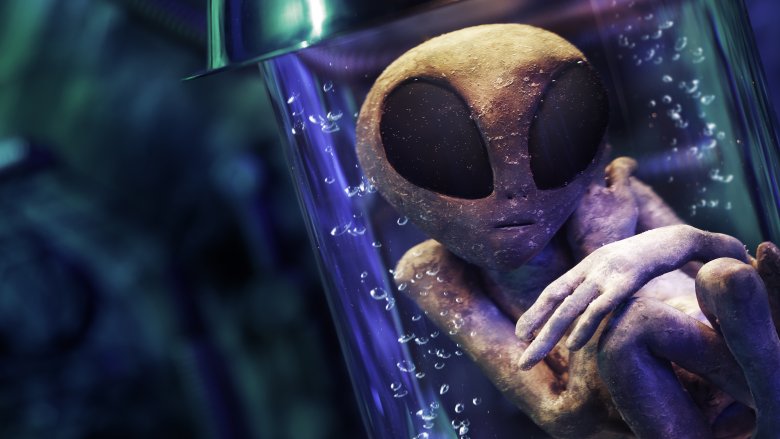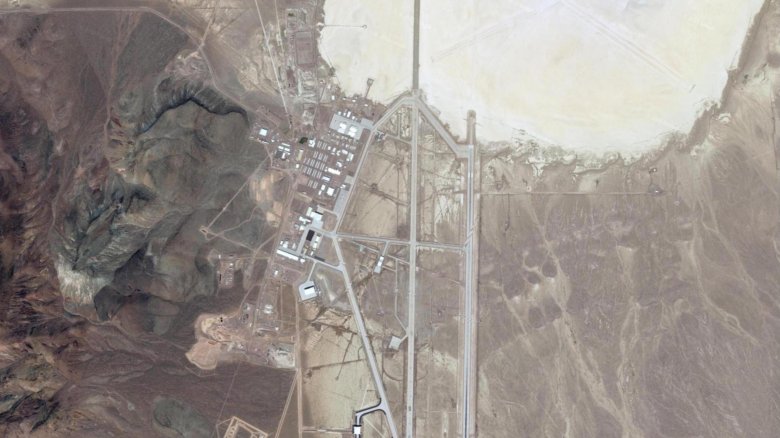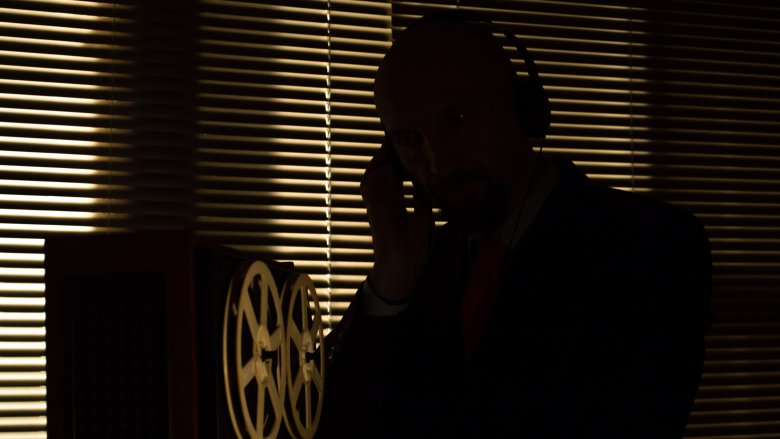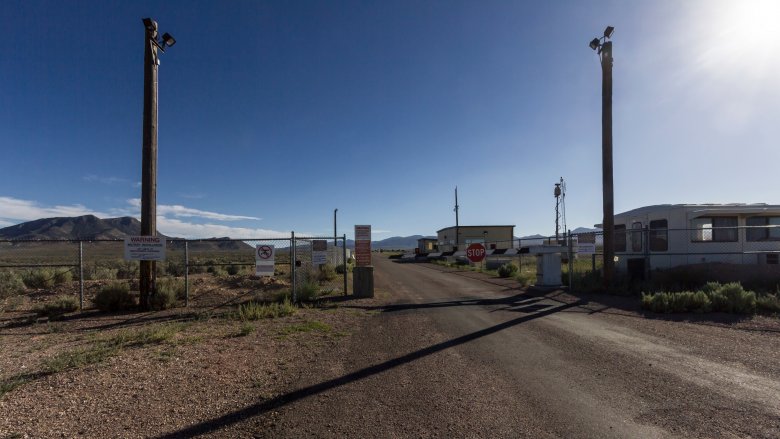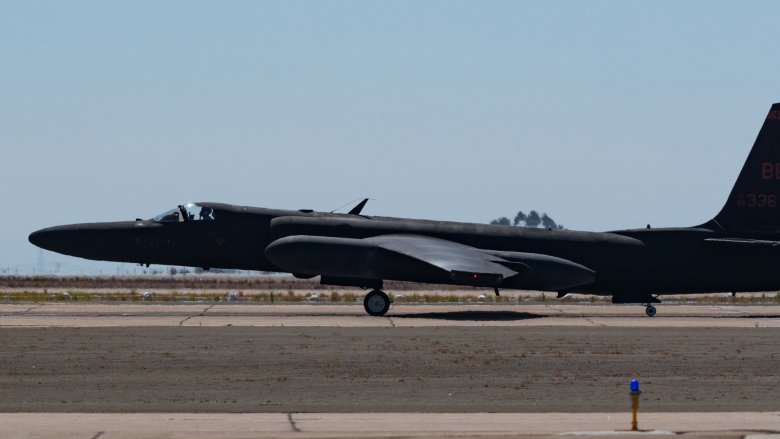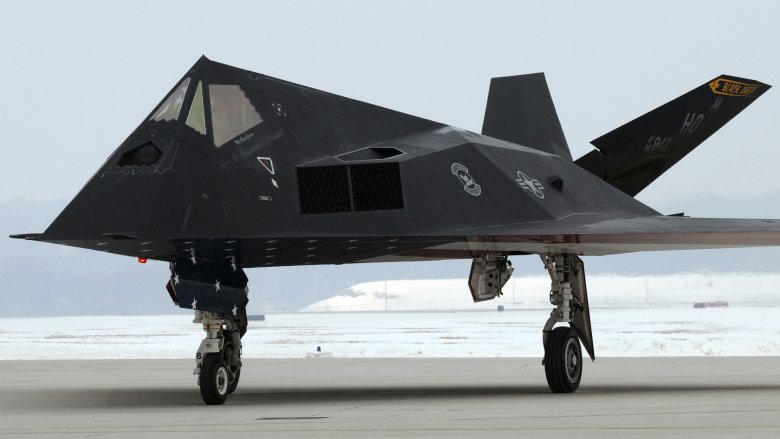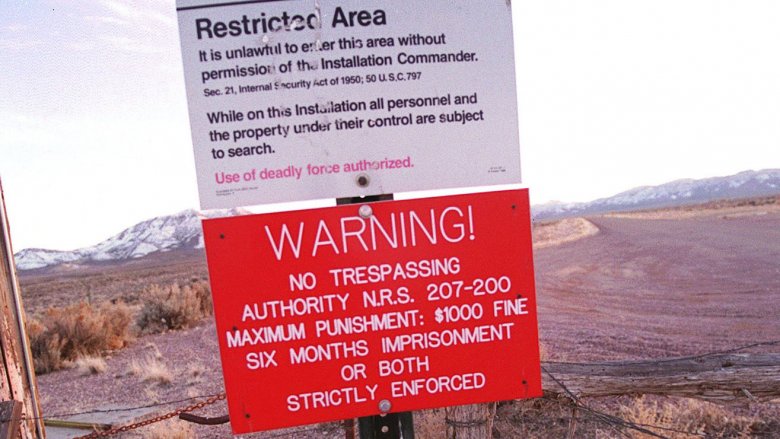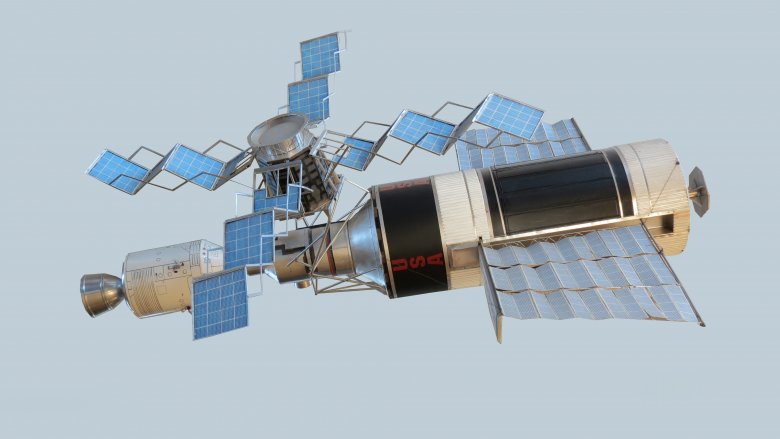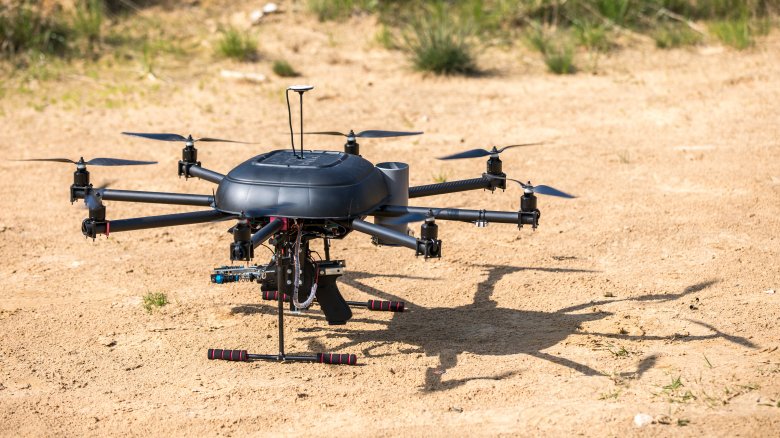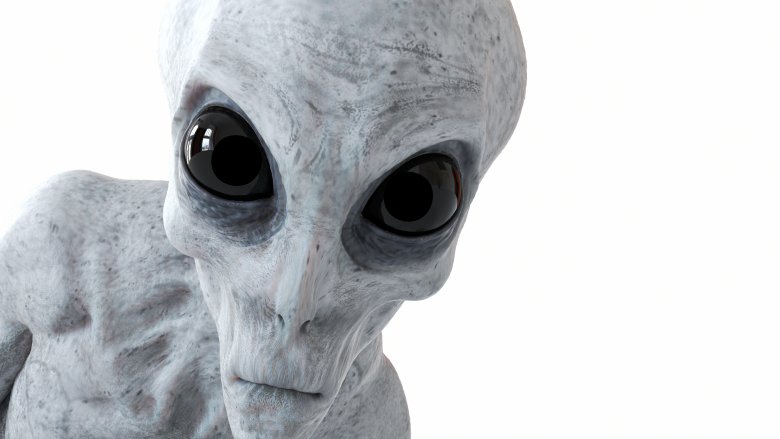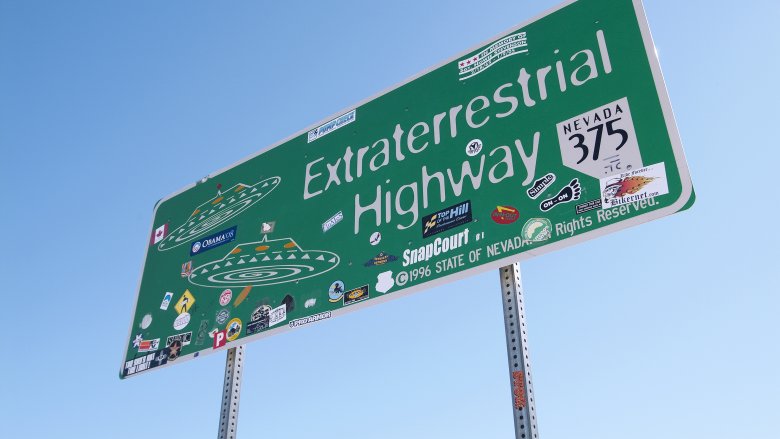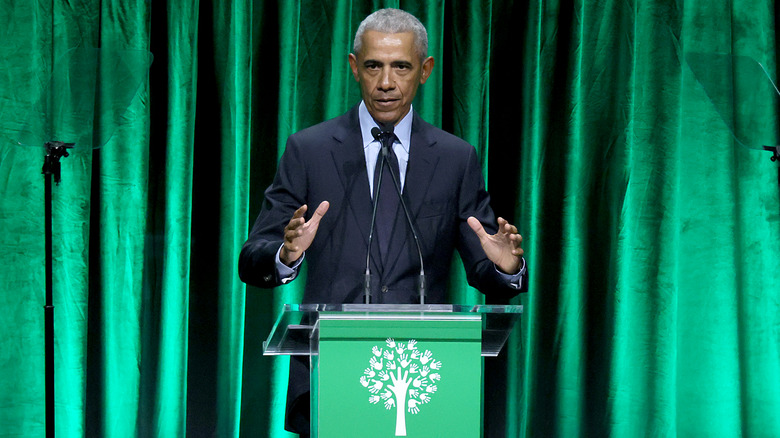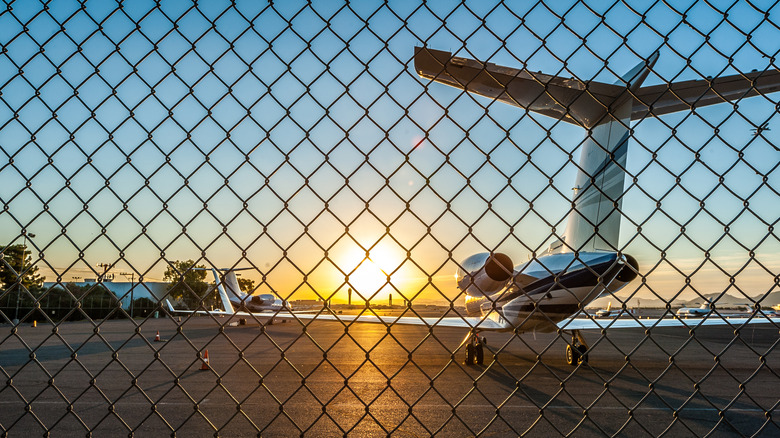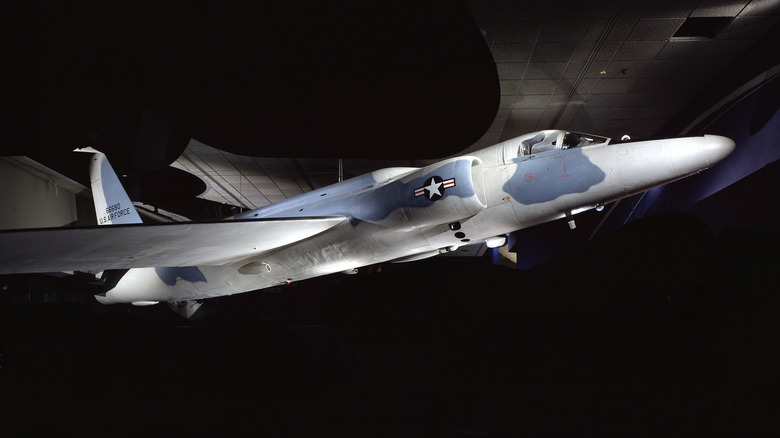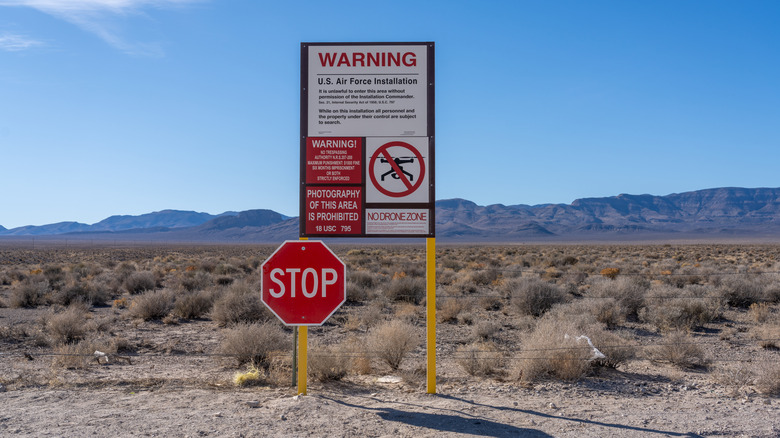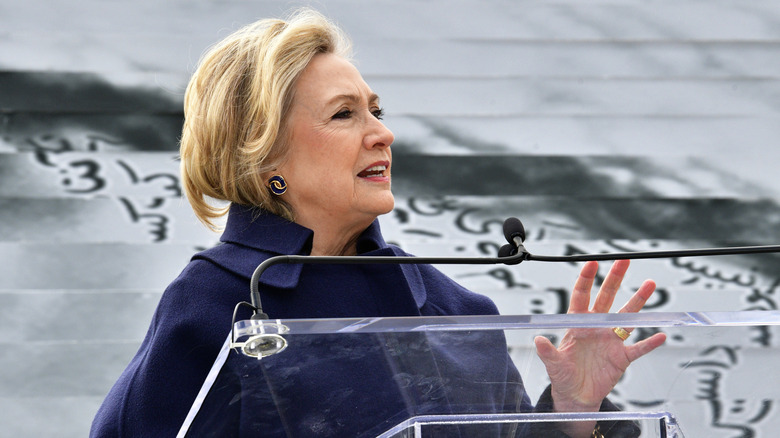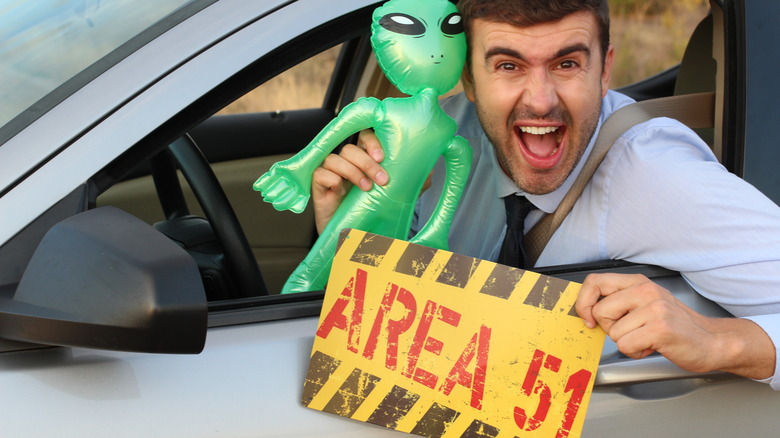Area 51: From Government Secrecy To Alien Conspiracies
When aliens come to Earth, they get studied at Area 51 ... or, at least, that's what some people will tell you. Is is true? Well, there's no question that this creepy government facility in the middle of the Nevada desert, officially called Groom Lake, has kept many secrets locked up in its vaults. So far, though, there's been no proof that a bunch of little green extraterrestrials are one of them.
That hasn't stopped people from speculating about — or threatening to "naruto run" into — the guarded facility, and considering that it took over a half-century for the United States government to even admit that Area 51 existed, you can't blame folks for not trusting the official story. What can be confirmed about Area 51, for sure, is that it's a place of high-tech military tests and shady cover-ups, the likes of which you would normally only find in an episode of "Stranger Things." Here's what we know about Area 51.
How the shady business at Area 51 all got started
Okay, so when you're talking about Area 51, separating fact from fiction is a tricky matter. That said, the Nevada Historical Society reports that this whole shebang got started during World War II. Somewhere between harnessing atomic energy and turning a skinny kid named Steve Rogers into a super-soldier, the U.S. military built a pair of small runways right next to Nevada's Groom Lake and named it the Army Air Corps Gunnery School. Sometime after the war, the Gunnery School was abandoned. No biggie.
Enter the paranoid 1950s, whereupon the equally-paranoid CIA teamed up with the somehow-even-more-paranoid Lockheed aerospace corporation. Their joint project, labeled Skunk Works, was intended to develop U-2 spy planes. The secrecy of the project meant that test flights had to be done in a remote location, far away from commercial and military flight paths, but close enough to a major city that receiving new supply shipments wouldn't be a total pain in the neck. Luckily, the project's Air Force liaison mentioned that nice little abandoned Gunnery School in Nevada where he had trained. After close inspections, Skunk Works moved in, set up shop, and started testing their spy planes.
Obviously, they didn't tell any of this to the press. Their cover story was to refer to the military base as "Watertown" and claim that they were merely studying weather phenomena, as per "Area 51," by Peter Merlin. Huh, sounds familiar.
The government didn't officially acknowledge Area 51's existence ... until 2013
These days, the existence of Area 51 is common knowledge. Nobody knows what they do there, exactly, but everyone knows that it's a real place. Throughout the entirety of the 20th century, though, the U.S. government refused to even admit that much. Yeah, seriously. It wasn't until 2013 that the CIA finally came clean about the test site's existence, according to Reuters, through declassifying some old documents about the subject. By this point, the "X-Files" theme was already embedded in people's brains, and decades of lying doesn't do a lot to inspire public trust, so a lot of people weren't too inclined to buy the CIA's fancy-schmancy story about the base being used to test fly high-tech military weaponry ... as opposed to, you know, studying alien bodies from the Roswell incident or what have you.
Nonetheless, much of what the world knows today about Groom Lake's history is thanks to the 400 pages the CIA made public, and it does seem quite credible that the base's primary intention has, indeed, been about testing experimental military aircraft. Now, as for aliens playing a role in those experiments? You be the judge.
There's a crazy level of secrecy at Area 51
If you're wondering how a sketchy government base could stay hidden so long, well, the cloud of secrecy surrounding Area 51 is big and foggy enough that even Agent K would get lost in it. First of all, as NPR points out, you have to understand that Area 51 isn't some dinky little hole in the desert. The base is stationed inside a 4,687-square-mile piece of land that's way bigger than Rhode Island, and almost the size of Connecticut. Whoa, right?
Secondly, they don't kid around when it comes to privacy invasions. According to How Stuff Works, any pilots brave enough to fly into the airspace above Area 51, named R-4808N, face a deadly trio of horrible consequences, starting with a court martial, leading to a dishonorable discharge, and potentially culminating in time behind bars.
Third, a former Area 51 worker named T.D. Barnes describes a professional environment so secretive that non-disclosure agreements are used for everything, the jobs don't officially exist on the books, and less than 5% of those on the base even knew the CIA was involved. In an interview with a local Las Vegas news station, Barnes said people on the base communicated with fake names and weren't even allowed to tell their families back home where they worked: Barnes' wife thought her husband commuted to a foreign country, until he told her the truth in 2009.
Whoa, hold on. So what's actually at Area 51?
The honest answer about what's really at Area 51 is "nobody knows for sure." Except for the people who do know, obviously, and they certainly aren't going to tell you about it.
That said, you can be reasonably certain that the whole area is used for testing high-tech experimental military aircraft, according to The Washington Post. The CIA's declassified documents definitely make it clear that this was how the base was used throughout most of the 20th century. In addition to those U-2 spy planes, How Stuff Works points out that Lockheed's A-12 Archangels were also tested there in the 1960s, followed by stealth fighters in the '70s, and Tacit Blue aircraft in the '80s. So, presumably, the military is currently flying some ludicrously advanced new aircraft models out there today, the likes of which we won't see unveiled to the public for another few decades. It makes sense.
... or, you know, they could have aliens there, right? Right? Considering it took decades for the U.S. government to even admit the place existed, lots of people still believe there's shady crap going on in there, whether UFO-related or not. You can't blame 'em for being suspicious, that's for sure.
Where'd all these alien conspiracies come from?
Well, c'mon, when there's a mystery afoot, people always suspect aliens. Just ask that "aliens" dude on the History Channel. The real credit for establishing a permanent link between Area 51 and aliens, though, probably goes to a guy named Bob Lazar. Newsweek reported that in 1989, Lazar — under the pseudonym "Dennis" — told the press that he was a former scientist who had worked in Area 51, reverse-engineering nine extraterrestrial flying saucers. Boom.
Once "Dennis" spoke out, the world flipped on its axis. Nobody stormed Area 51, but the news spread like wildfire, and Lazar's story turned Area 51 into UFO central, forevermore. Soon afterward, Lazar came forward with his true identity, claiming that his family's lives had been threatened.
According to Vice, a lot of what made Lazar's story stick — and why it continues to gain support, to this day — is because he's clearly a smart guy. Back in 1989, for example, he explained that the alien spaceship used element 115, aka moscovium, to manipulate gravity for its propulsion system: an impressive concept, since the element didn't get synthesized in a lab until 2003. This isn't quite the smoking gun it sounds like, though. While Lazar's descriptions were certainly knowledgeable, it's also the sort of concept a clever science fiction author could cook up with some research. Lazar has credibility issues, too, as his claim of studying physics at MIT doesn't line up with MIT's records. Still, he has many followers.
UFO sightings abound around Area 51
Again, the official government line is that there are no flying saucers in Area 51. There have been plenty of UFO sightings in the area, according to Britannica, but these are generally chalked up to people misinterpreting real military tests. For example, imagine if you were in the 1970s and you saw something like the stealth fighter above zoom past your head. Wouldn't you be freaked out? Plus, once enough people say there are UFOs in a certain area, people tend to "see" more UFOs. So it goes.
That said, the CIA's declassified documents did contain at least one section regarding UFOs, which discusses something called Operation Blue Book. (Cue creepy music.) As summarized by Space.com, the CIA noted a dramatic increase in UFO sightings after the U-2s started being test-flown from Area 51, and while this seems like an obvious case of cause and effect, they did want to make sure. So they recorded UFO sightings, documented them, and compared the locations against U.S. aircraft flight logs to check that nothing funny was going on. Using this method, Blue Book officials were able to confirm that the majority of UFO sightings matched military aircraft flight patterns.
Note the word "majority," though. This terminology doesn't prove anything, and it's easy to jump to conclusions, but it is a word choice commonly seized upon by UFO folks. Again, believe what you will.
They're awfully serious about security at Area 51
If you're wondering how the U.S. government is legally able to keep people from entering Area 51, well, it's enshrined in the law. Section 1382 of Title 18, to be precise. According to IFL Science, Area 51 is surrounded by signs warning trespassers that they could be subject to deadly force, heavy fines, and/or prison time.
How seriously do they take these laws, though? After all, would they really shoot someone who charged past the barriers? Yes, actually. In January 2019, the Nevada National Security Site reported that an unidentified man holding a "cylindrical object" had broken in, driven 8 miles past the security gate, and ignored the commands of the officers who intercepted him. Yes, they shot him, and yes, he's dead now.
A somewhat less deadly incident occurred in 2014, when a tour van carrying four passengers accidentally crossed the boundary, according to Las Vegas Now. Two minutes later, the guards roared out in a white truck, stopped the van, and issued misdemeanor charges and $650 fines ... for each person in the van, passengers included. Thankfully, the charges were dropped for the passengers, but the driver was barred from doing Area 51 tours for two years.
The 1974 Skylab photography snafu
You'd be hard pressed to find two government agencies more different than NASA and the CIA. While NASA is all about openness, the CIA hides things under the things it hides. These contradictory approaches came swinging at each other like two "Mortal Kombat" opponents back in 1974, according to the Space Review, when astronauts aboard the Skylab 4 mission accidentally snapped an aerial photograph of the infamous Area 51. Oops.
Now, keep in mind, at this point Area 51 was off the books, nonexistent, etc., so the CIA was extremely unhappy about having their dirty laundry put on camera. A CIA memo (PDF) dated April 19, 1974, states in clear terms that, "The issue arises from the fact that the recent SKYLAB mission inadvertently photographed [REDACTED]. There were specific instructions not to do this. [REDACTED] was the only location which had such instruction." This prompted a big battle, with NASA wanting to release the photo and the CIA resisting. In the end, though, the Space Review says that the photo was published in NASA's archive of Skylab pictures, so while NASA seems to have won, the photo (sans context) was so seemingly uninteresting that nobody noticed.
None of this came to light until 2006, by the way.
The only thing in Area 51 scarier than the aliens? Combat drones
Want to hazard a guess about where the CIA first tested the unmanned, flying death machines we now (incorrectly) call "drones"?
Area 51, of course. While this might sound like the sort of wacko theory that the conspiracy dude at your local bar would rant after a few drinks, The Washington Post confirms that it really happened. To make matters even creepier, drone development isn't a recent thing, either. The two drone programs at Area 51, named AQUILINE and AXILLARY, first got started in the '60s as a response to all the U-2 spy planes getting lost. Both of these projects ended up being canceled, as AQUILINE cost too much and AXILLARY was too loud for proper spy missions. However, they certainly paved the way for the deadly combat drones we see being used in wars today, and at least one of those AQUILINE prototypes took off from Area 51 over 20 times ... and, presumably, caused at least a few UFO sightings.
What's in a name?
The truth is, nobody actually knows why, exactly, this mysterious base is called Area 51. According to Dictionary.com, this name was first discovered on diagrams from the 1960s, and it's possible that the name is just a relic from the Atomic Energy Commission, which used a grid naming system (Area 13, Area 14, you can count) to title the various "safety experiment" locations within the land of Nellis Air Force Base. That said, Area 51 is far from the only name this location has had, and it's doubtful that those who work there call it that. If anything, they probably think of it as Groom Lake. The location's airport identifier code is KXTA, and according to Wired, another official name for it is Homey Airport. Because top-secret military installations are so homey, right? Maybe it's a reference to E.T.'s phone.
Anyhow, plenty of Area 51 nicknames have appeared throughout the years, as described by The New York Times, all of which sound straight out of a science fiction horror movie. These include Dreamland, the Box, the Ranch, or — simply enough — "the remote location." Shudder.
Where there's weird stuff, tourism follows
Nobody goes into Area 51 unless they're invited, but the surrounding region has — predictably enough — flowered with exactly the sort of alien-themed tourism you'd hope to find in such a location. The New York Times writes that Nevada State Route 375 was named "the Extraterrestrial Highway" in 1996, and the area welcomes visitors from any planet to enjoy the various museums, restaurants, and hotels dedicated to the little green dudes, according to the Washington Post. Honestly, outside of Roswell, New Mexico, or the annual Exeter UFO Festival in New Hampshire, it's hard to find a more alien-friendly spot ... well, unless there really are alien bodies being dissected in Dreamland.
Tourists shouldn't expect to actually go inside Area 51, though. Also, don't believe all the hype: While salespeople love to claim that Nevada sees more annual UFO sightings than anywhere else in the country, USA Today reports that this honor actually belongs to Vermont, followed by Oregon.
Nevada, for what it's worth, ranks at #13.
Barack Obama was the first president to mention Area 51
It's odd that the government is so reluctant to acknowledge the existence of a military base that's so well known to the masses. All the government's silence does is make us all the more curious about what's actually going on at Area 51. However, after decades of general secrecy about the base, in 2013 President Barack Obama became the first president to mention Area 51, but not to declassify anything juicy about it. No, the president brought it up in the form of a joke, according to NPR. Specifically, it was at the annual Kennedy Center Honors ceremony wherein actress Shirley MacLaine was being honored for her contributions to the arts. When presenting the actress, Obama said, "Now, when you first become president, one of the questions that people ask you is, 'What's really going on in Area 51?' When I wanted to know, I'd call Shirley MacLaine. I think I just became the first president to ever publicly mention Area 51. How's that, Shirley?"
While it's technically true that Obama was the first president to publicly mention Area 51, CBS News lists previous times when other presidents publicly mentioned Groom Lake, Nevada, which is generally thought to be an allusion to the infamous military base. For example, President Bill Clinton made references to Groom Lake in 1996, 1998, 1999, and 2000, while President George W. Bush referred to it 2001, 2002, 2003, and 2004.
Employees reportedly fly to work on Janet Airlines
Area 51 is so secretive that employees aren't even allowed to drive there for work but instead must take a designated plane to and from there. SOFREP states that the roughly 1,000 to 1,500 Area 51 employees fly to the base from Las Vegas' McCarran International Airport on JANET Airlines' jets. The airline has its own terminal at the airport and consists of a modest armada of Boeing 737-600 jets, as well as three Beechcraft 200Cs and two Beechcraft 1900s. Adding to the mystique of the aircraft is their appearance, which consist of all white paint jobs and no logos. While this may have been done to not attract attention to them, it's about as inconspicuous as a plain white van parked outside of your house for days on end.
According to SOFREP, some joke that JANET stands for "Just Another Non-Existent-Terminal." While that's probably not true, what is true is that the airline is owned by parent firm AECOM. And for those who are in the market for a new job -– ideally one with a secretive government operation –- Task & Purpose (via Military.com) has some details on pilot positions with the defense contractor. Applicants must have 3,000 hours as a pilot, as well a top-secret government clearance. It should go without saying that prospective pilots should be good at keeping secrets, of course. Still, for around $80,000 a year, the gig doesn't sound too bad.
Project Aquatone and the development of Oxcart and Nighthawk
The National Interest states that the United States grew concerned about reports of the Soviet Union's growing nuclear arsenal during the Cold War and needed a way to monitor their progress. Because of the Soviet Union's advanced air defense system, this would require the invention of a new kind of plane. That's when Lockheed came up with a spy plane that could fly higher than radar could detect. President Dwight D. Eisenhower signed off on the project, called Project Aquatone, and the U-2 spy plane was built. As Curtis Peebles writes in "Dark Eagles," a special facility was built near Groom Lake, Nevada, to test the plane, which would go on to be called Area 51.
Of course, the U-2 spy plane wasn't the only clandestine program worked on at Area 51. According to National Geographic, not long after Project Aquatone, the U.S. military began progress on Oxcart, another spy plane that could fly over Russian soil and collect important information without being detected. But because they knew when Soviet satellites would be flying over the base, personnel at Area 51 created a variety of solutions to make their job more difficult, such as building fake planes to confuse satellites and moving spy plane prototypes into sheds when satellites drew near. The F-117 Nighthawk is another plane tested at Area 51. As stated by Lockheed Martin, what made Nighthawk special was its ability to not only evade radar waves but to reflect them back, making it ideal for spy missions.
Area 51 was involved in a lawsuit
Filing a lawsuit against a military base whose existence the U.S. government has historically been reluctant to even acknowledge is no small feat, but that didn't stop Jonathan Turley who, as he states in the Los Angeles Times, did just that in the 1990s. According to Turley, several men who worked at Area 51 came to him regarding the health problems they suffered from their time at the base, stating that used equipment, waste, and other materials were being disposed of in a harmful and illegal manner. According to the suit, the matter in question was dumped into long trenches, covered in jet fuel, and set aflame, resulting in massive clouds of smoke around the base. The fumes, of course, are alleged to have caused numerous serious health problems in employees.
The Washington Post elaborates on the details of the lawsuit, which is not to seek monetary recompense but rather to force the military to divulge what chemicals the infirmed plaintiffs were exposed to so that they could get the medical treatment for their specific needs. Unfortunately, the U.S. government cited reasons related to national security for why it couldn't disclose the waste it was disposing of at the base. While the lawsuit did prompt the EPA to carry out an inspection of Area 51 -– the first in the secretive base's history –- its findings could not be shared.
Hilary Clinton wanted the government to open up about Area 51
While it may seem like most in the U.S. government are remaining tight-lipped about Area 51, Hillary Clinton, the former secretary of state who ran for president in 2016, took a different approach. As stated in the Daily Caller, during an appearance on "Jimmy Kimmel Live," she told the host that, if elected president, "I would like us to go into those files and hopefully make as much of that public as possible. If there's nothing there, let's tell people there's nothing there." Clinton did qualify, however, that anything threatened national security would remain top secret from the public.
This seems a reasonable compromise, making it all the more confusing as to why so few others involved in government have made this proposition. The New York Times states that, during her presidential campaign, Clinton's statements about Area 51 resonated with conspiracy theory aficionados who've long speculated about what the secretive base is hiding. During a radio interview around this time, she even expressed her belief in the possibility of UFOs, saying, "I want to see what the information shows," but that "there's enough stories out there that I don't think everybody is just sitting in their kitchen making them up."
Storm Area 51, Explained
CNN reported in 2019 that a Facebook event was created with the intent of gathering up as many people as possible to "storm" Area 51 to make contact with the aliens supposedly being kept there. Of course, the whole thing was a joke, as even a cursory look at the event's description shows that it's not to be taken seriously. For example, the event itself was called "Storm Area 51, They Can't Stop All of Us," with the description reassuring participants that doing a "Naruto run" at the base would allow them to dodge bullets. Even though the event page was obviously written as a gag, because more than 2 million people signed up for it, there was some speculation that some might take it seriously and make a charge at a heavily-guarded military base.
Luckily, however, not much came of the event, according to CNN. Apparently, only around 3,000 people showed up in the nearby region, but almost everyone decided that charging into Area 51 was a bad idea. Lincoln County Sheriff Kerry Lee told the outlet that "they did threaten that they were going to storm," but "once officers warned them about the consequences for storming the base, they did have second thoughts." The day wasn't entirely without incident, as someone was arrested for indecent exposure and another for threatening to storm Area 51. But overall, it was a fairly uneventful day, and police officers had largely positive interactions with the crowd that arrived.
